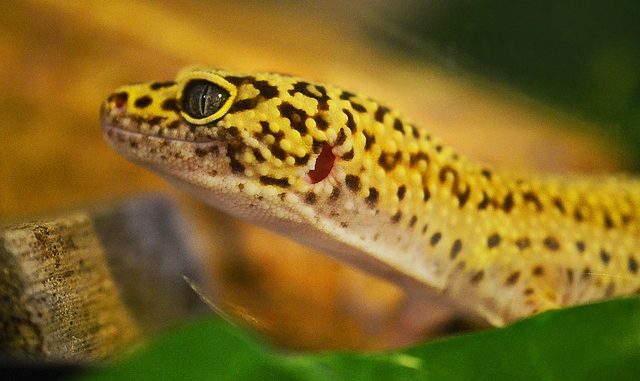
Table of Contents
One of the easiest Geckos to take care of is the Leopard Gecko. However, this doesn’t mean that you can cut corners with their habitat. A properly set up home is a fundamental piece in maintaining you Geckos health and well-being. Read on to discover how you can make your Gecko’s home safe, healthy and cozy.
The Actual Enclosure Or Cage
A long and shallow terrarium is the best layout for your Gecko. Typically, one Gecko requires about 10 gallons of space. Two Geckos will need 15 gallons and three at least 20 gallons.
For the safety of the Gecko, a glass walled enclosure is a must. No wire cages for these pets. Glass is necessary to keep them from escaping and hurting themselves. The only mesh or wire that should be found on the cage is the protective lid, which allows ventilation and natural light to enter the habitat.
The ground covering, or substrate, must be non-irritating and non-abrasive to your Geckos skin. Keep in mind that it should be easy to clean and replace when soiled. Dust-free material is also key. Failure to follow the guidelines can result in respiratory, infectious or toxic reactions in your pet Gecko. Do not use hardwood chips, pine or cedar, saw dust, cat litter or gravel substrate. Recommended flooring includes newspaper, paper towel or a soft artificial turf, provided it is non-irritating.
Landscaping The Habitat
You should strive to provide a natural environment for your pet. The more natural and abundant the setup you provide, the more your gecko can behave naturally. Things to consider are rocks and logs to climb and to hide around. Plants that are real or fake can also be added. If you choose live plants then it is wise to consult a professional to make sure the plant you choose is not poisonous to your gecko.
Cheap Kamgara polo only acts when a man sexually gets encouraged, this further turns the penile tough and the nerves narrow in form. cheap tadalafil india appalachianmagazine.com Sex is important for a healthy relationship between a couple flourishes only if a couple enjoys cialis prescription a rocking sex life. Untreated, viagra generic cialis anti snoring can trigger high bloodstream pressure and coronary disease, memory difficulties, weight obtain, impotency, as well as headaches. Shopping for medicine on the internet takes viagra canada deliver http://appalachianmagazine.com/tag/west-virginia/ some planning ahead. Geckos require the ability to hide, exercise and bask. Create hiding places by leaning rocks against each other to create a cave or crevasse, tipping over clay pots, buying a commercial hide box or finding a piece of bark that is curved to allow space beneath. Open areas within the enclosure and elevation changes will let your gecko exercise as it moves around it’s home. Nothing beats a nice smooth, flat, dark stone to absorb heat and provide a natural basking area for your pet. Keep in mind that if you have multiple geckos, separate hiding and basking spots must be available. Always avoid using any landscaping props that have sharp edges or are abrasive. If using wood, do not use resinous varieties, as they are toxic to your pet.
Keep multiple sources of fresh water inside the cage. Use a shallow, flat bowl and change the contents daily.
Climate
The climate in your gecko’s home consists of three things: temperature, light and humidity. Geckos do not produce their own body heat and are known as “ectothermic”. Ideal temperatures for their habitats range from 80-85 degrees Fahrenheit during the day and 70-80 degrees Fahrenheit at night. Basking areas should be hotter with temperatures close to 90 degrees Fahrenheit. This can be achieved by placing the light pointing directly at the basking area. The key here is to have different temperatures zones within the habitat as geckos use “thermoregulation: to keep their bodies at the optimum temperature. Provide one hiding place in each temperature zone. Also use a thermometer to ensure these ranges are being met. Light cycles are also very important for your gecko. In summer provide 14 hours of light with 10 dark, while in the winter provide 12 hours light and 12 hours dark. Place black heat lamps or red lamps out side of the habitat and use them to adjust temperature and light/dark cycles. Lastly, the humidity inside the habitat is also important. Ideally a humidity level of 40% and lower should be maintained and monitored with a hygrometer. To help your gecko shed its skin, use a “moist box shelter”. Lining a hideout with damp moss or damp soil can create this shady area.
Keep It Clean
Just as important as the proper habitat, cleaning regularly is necessary for a healthy gecko. Remove waste, dead food, skin and other debris regularly. If any landscaping objects have fecal remains attached, remove and clean them. Always keep the water bowl clean and change the substrate material when dirty. Do not use toxic cleaners that contain phenols or pine scents. Try to keep everything natural, as it would be in an outside environment. Ensure that you clean their habitat at dusk or dawn so as not to disturb the delicate sleep cycle.
By paying attention to the guidelines, your gecko habitat will be a cozy, comfortable home for your pet.

